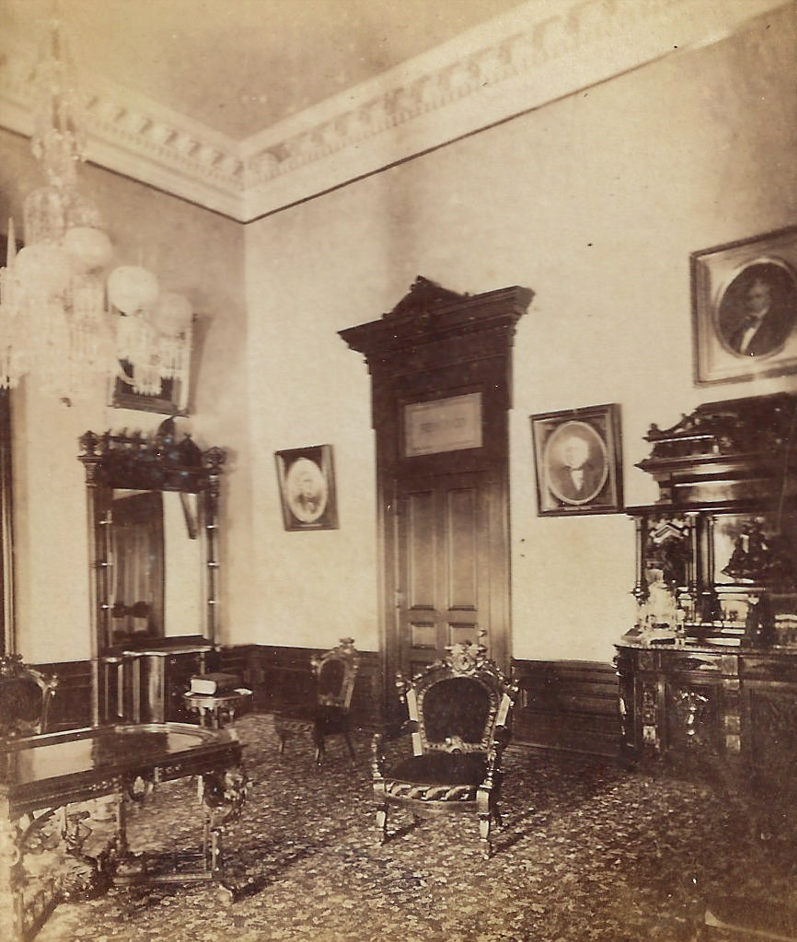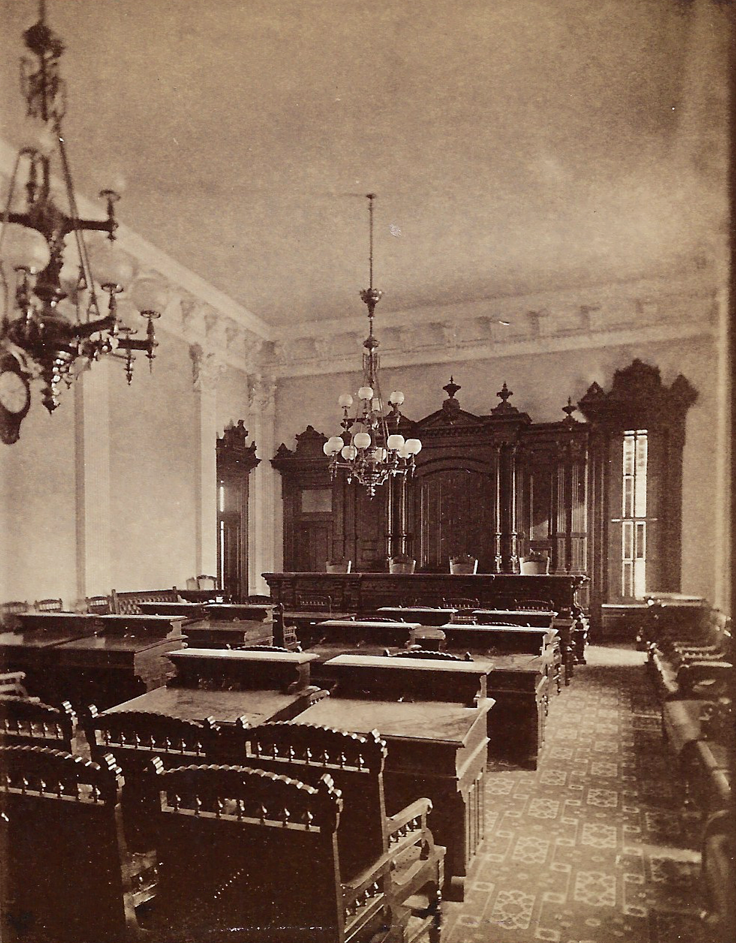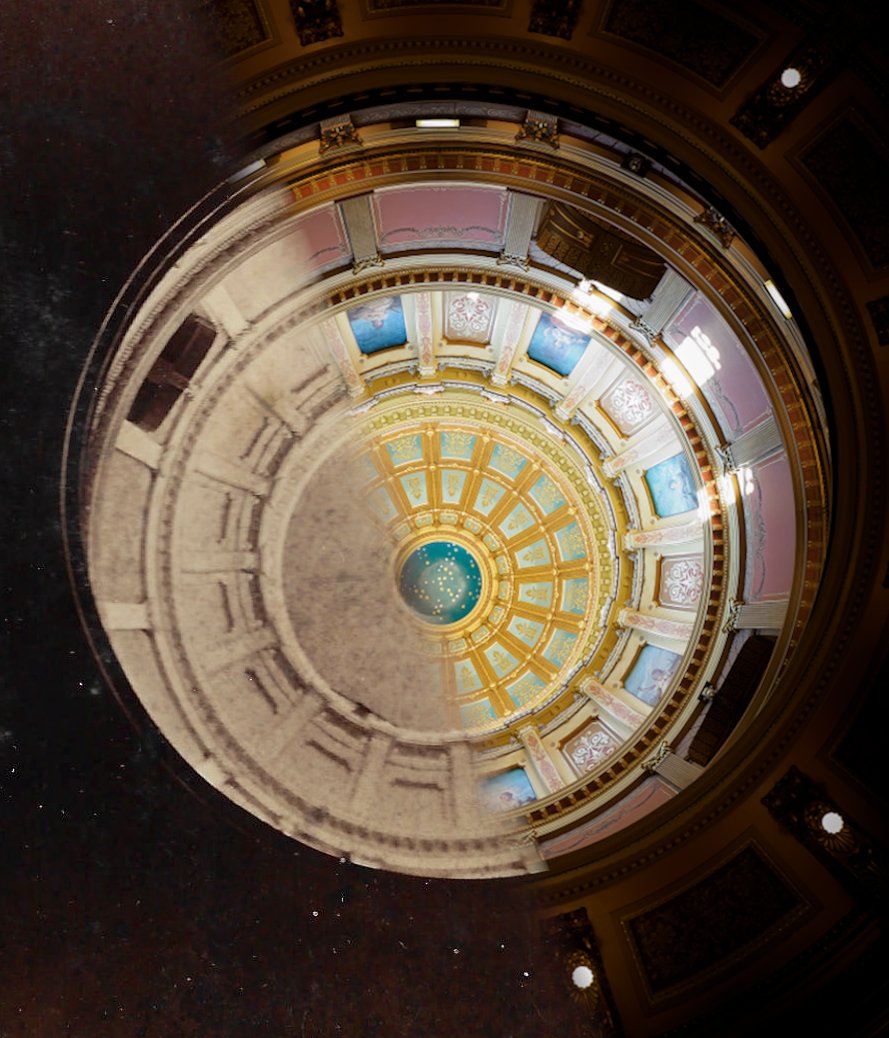
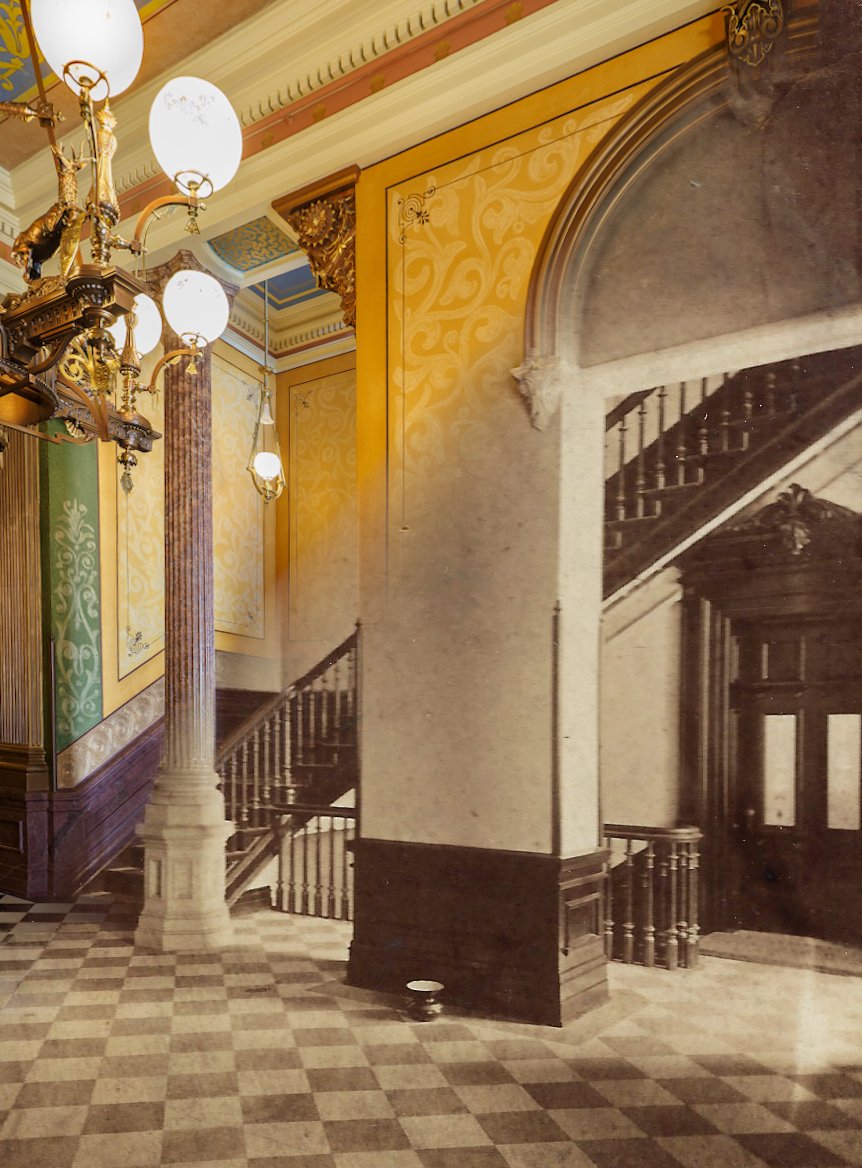
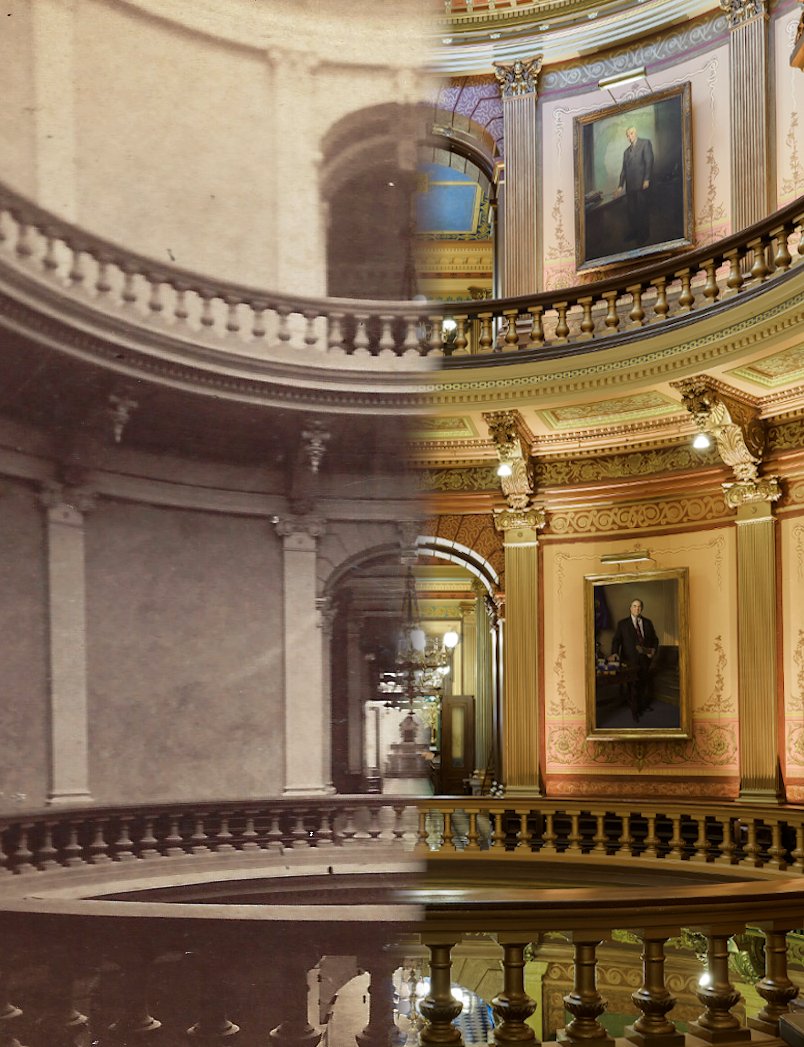
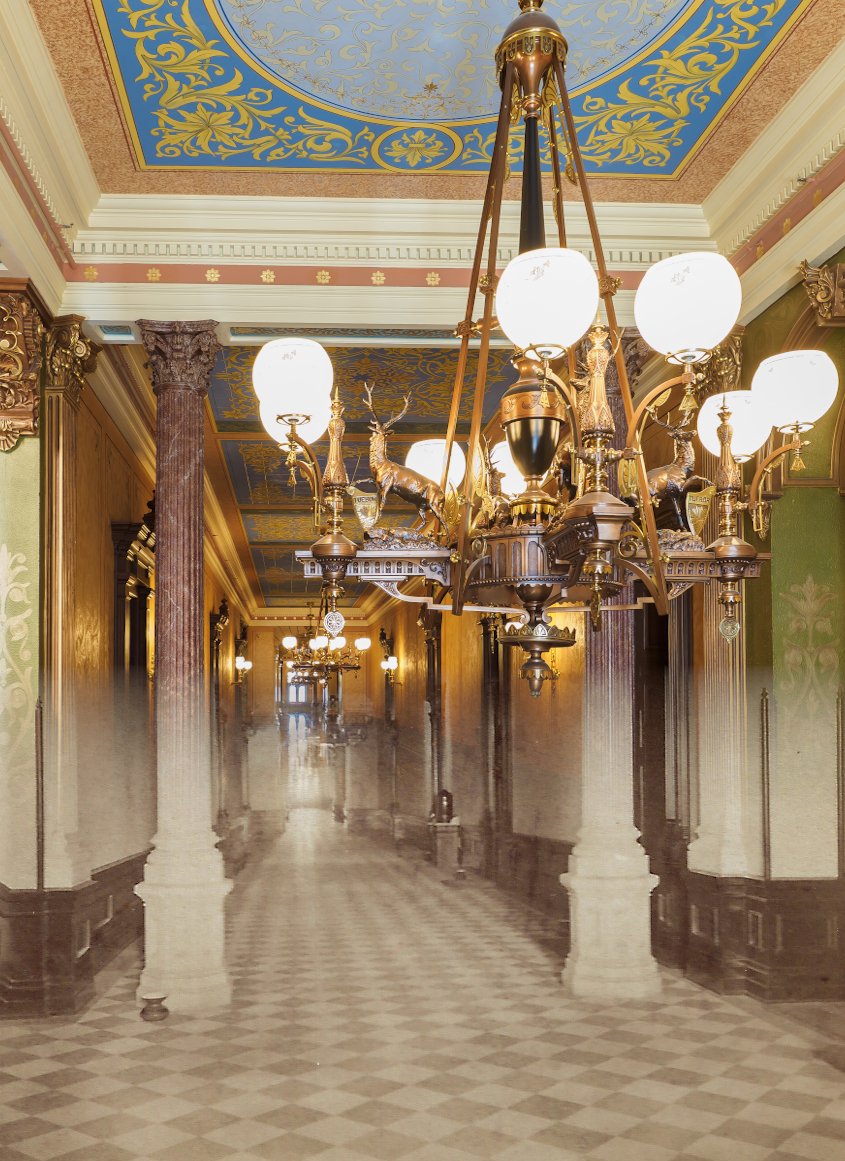
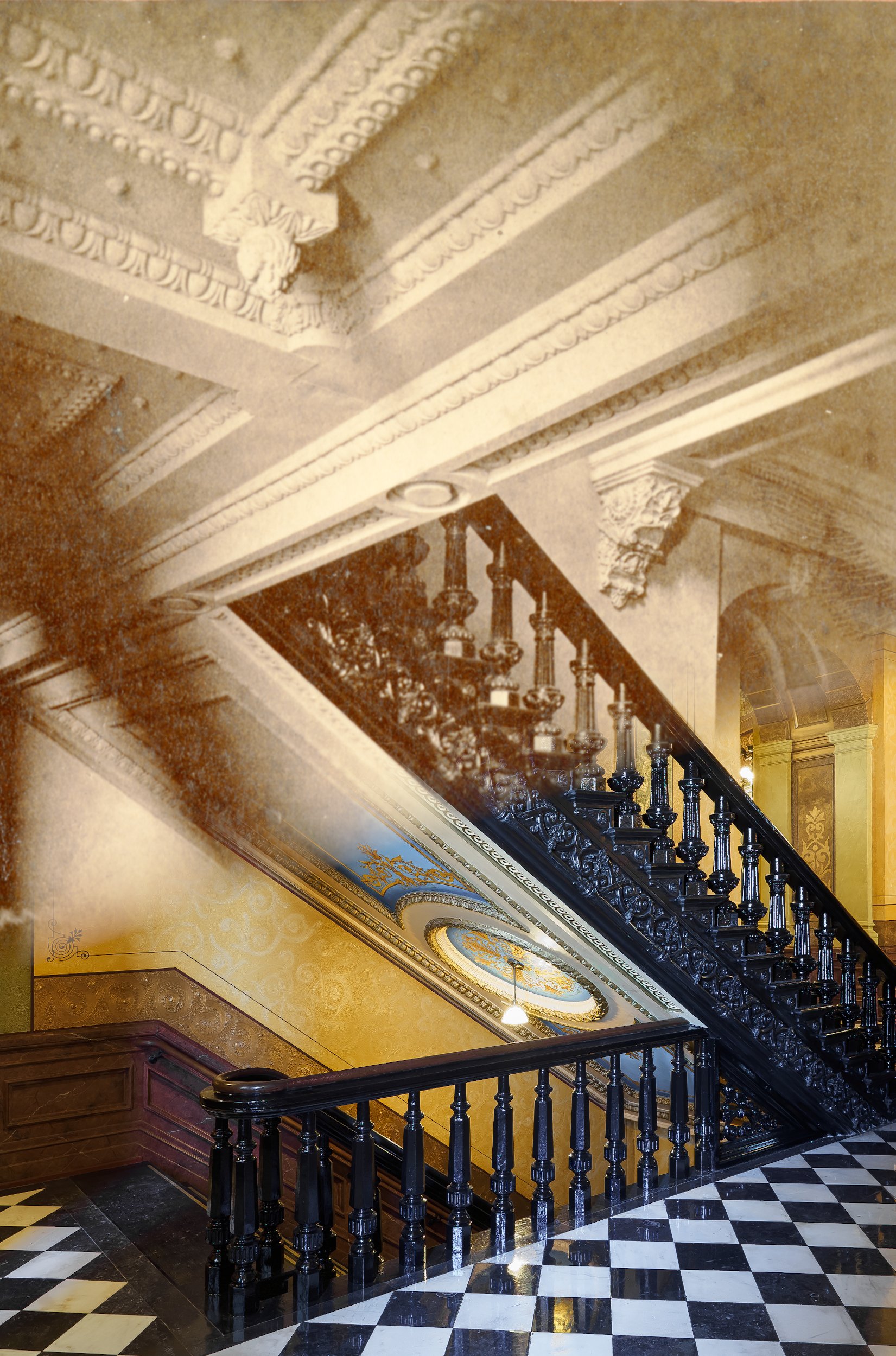
A Very Public Painting Project
Today Michigan’s Capitol is famous for its elaborate Victorian style artwork. Yet when the building opened in 1879, few of the interior surfaces were finished. Finally, after six years of delay, the process of decorating the Capitol’s walls, ceilings, and columns began in 1885. Like everything else that has happened under the dome, this transformative project was reported on in various newspapers.
Jan. 2, 1879 – The Post and Tribune describes the Capitol and notes that “the large expanse of white or light colored walls is somewhat tiresome to the eye,” but that this will eventually be fixed once the Legislature orders them to be painted.
Jan. 6, 1881 – Governor Charles Croswell states in his message to the Legislature that the walls of the Capitol are “now thoroughly dry” and painting them should be considered. (Journal of the Senate pp. 15-34)
Phase I (June 1885-January 1887)
Jun. 5, 1885 – First Decorative Art Appropriation Passed. In Public Act 140 of 1885, $25,000 is appropriated by the legislature for “frescoing and decorating the walls and corridors of the State Capitol.”
Late 1885 – A State Capitol Decoration Board is created to develop and award a contract.
Sep. 1885 – Advertisements for the frescoing of the Capitol are placed in the Detroit Post, the New York Tribune, and the Chicago Tribune.
Nov. 1885 – The contract to decorate the Capitol is awarded to the William Wright Co. of Detroit.
Dec. 18, 1885 – Painting Begins in Governor’s Rooms. The Lansing Journal Weekly reports that “the work of frescoing the capitol building has been commenced. The Governor’s room will first come under the decorator’s brush.”
Jan. 8, 1886 – Painting Begins in the House of Representatives. The State Republican reports on Saturday Jan. 9, that “the work of frescoing Representative Hall commenced Friday afternoon. The decorations in the governor’s reception parlor are being pushed rapidly toward completion.”
Jan. 27, 1886 – Preparations Begin in the Senate. The State Republican says, “the Senate chamber carpet has been taken up, the furniture torn out, and Mr. Wright’s workmen are putting up scaffolding preliminary to beginning the frescoing.”
Feb. 12, 1886 – “The decorations in the Governor’s reception parlor have practically reached completion.” (The State Republican)
Feb. 15, 1886 – The Governor’s Parlor is Completed. The State Republican also adds, “the decorations in Representative Hall will be finished in about three weeks.”
Feb. 25, 1886 – “Arrangements have been made with William Wright to decorate Governor Alger’s private parlors, and work will probably begin next week.” (The State Republican)
Mar. 2, 1886 – Work on the Governor’s Private Parlor Begins. On March 1, The State Republican reports, “Workmen are putting up the staging in the Governor’s private parlor, and the decorators will begin tomorrow. Representative hall will be finished this week and the work in the Senate chamber is going ahead rapidly.”
Mar. 15, 1886 – Work in the House of Representatives is Completed. On Saturday, March 13, The State Republican says, “The decorations in Representative Hall will be completed Monday. The artists are now giving the finishing touches to a magnificent State coat of arms in gold over the Speaker’s Chair.”
Mar. 27, 1886 – The Governor’s Private Parlor is Completed. The State Republican reports, “The decorations in the Governor’s private parlor are finished. They harmonize with those in the reception parlor, the ceiling being of precisely the same tints, although materially different in design.”
Apr. 2, 1886 – “A new carpet has been ordered for Representative Hall and will be received in about two weeks. It will be purchased under the eye of Mr. Wm. Wright in order that it may harmonize with the decorations. The desks will not be replaced in the hall until after the legislative reunion and semi-centennial celebration in June. The Senate will also have new carpet.” (The State Republican)
Apr. 15, 1886 – “The old carpet has been relaid on the floor of Representative Hall and will remain there until after the Legislative reunion, when it will be replaced by the new one ordered to harmonize with the decorations.” (The State Republican)
May 19, 1886 – “Scaffoldings have been erected in the front corridor of the Capitol and the decorators will soon begin work there. The Senate Chamber will be completed next week.” (The State Republican)
May 21, 1886 – “The new carpets for Representative Hall and the Senate chamber, ordered to match the new decorations, have arrived.” (The State Republican)
May 26, 1886 – Preparations Begin in the Rotunda. The State Republican reports, “The Capitol decorators have begun the erection of staging in the dome and the force will be transferred to that rather dizzy point as the front corridor is completed.”
Jun. 26, 1886 – “A change of plans for decorating the walls of the front corridor is delaying Wm. Wright’s workmen at the Capitol.” (The State Republican)
Jul. 7, 1886 – Painting Begins in the Rotunda. “The Capitol decorators have begun work on the rotunda.” (The State Republican)
Aug. 5, 1886 – “The new Senate chamber carpet, purchased to harmonize with the work of the decorating artists, is nearly laid.” (The State Republican)
Aug. 12, 1886 – “The decorations in the front corridor of the Capitol have been completed for several weeks with the exception of marbleizing the double row of supporting columns. The work has begun at last and one column was finished to-day. The finish resembles the red and gray mottled marble of Tennessee, and the effect is peculiarly rich and striking.” (The State Republican)
Aug. 28, 1886 – “The last of the marbleized columns in the front corridor of the Capitol received its final polishing to-day, and the work on them is now complete with the exception of marbleizing their ornamental caps.” (The State Republican)
Sep. 1, 1886 – The Front Corridor is Completed. The State Republican reports, “The scaffolding that has filled the front corridor of the Capitol for weeks has been removed, and a fair idea of the richness and artistic beauty of the decorations can be obtained at last.”
Sep. 6, 1886 – The First Floor of the Rotunda is Completed. “The staging in the Capitol rotunda was taken down to-day, and the decorators transferred to the second floor. The first floor has reached completion with the exception of the panels.” (The State Republican)
Sep. 22, 1886 – Work begins on hanging the eight muses painted by Italian artist Tommaso Juglaris. “On eight of the panels in the Capitol dome above the fourth floor allegorical female figures will be painted… A painting of Commerce was suspended before one of the panels this forenoon to try the effect.” (The State Republican)
Sep. 29, 1886 – “Contractor Wright of the capitol decorations has ordered all the marbleized pilasters in the rotunda changed to a darker hue.” (The State Republican)
Oct. 5, 1886 – The Supreme Court Room is Completed. “The October term of the Supreme Court began in the newly decorated court room at 9 o’clock this morning. Twenty motions were submitted, none being of importance save to the parties directly interested, and the large number of leading attorneys present varied their intellectual labors with admiring glances at the rich decorations.” (The State Republican)
Jan. 11, 1887 – The Dome is Completed. “The decorating of the vault of the Capitol dome has been completed.” (The State Republican)
Phase II (June 1887-January 1889)
Spring, 1887 – A controversy regarding the hiring of immigrants for state funded projects is discussed in the legislature.
June 3, 1887 – Second Decorative Art Appropriation Passed. In Public Act 135 of 1887, the Legislature appropriated an additional $20,000 for “continuing the frescoing and decorations of the walls, corridors and rooms in the State Capitol.”
Sep. 3, 1887 – Notice is given to contractors by the Board of State Auditors that the board will be accepting sealed proposals for “continuing the frescoing and decorations of the walls, corridors and rooms in the State Capitol upon the same general plan and design as pursued heretofore.” This will include “all the halls, corridors and staircases, the Governor’s offices, the post office, court room and anteroom, and the rooms of the Justices and the Supreme Court.” (The State Republican)
Oct. 26, 1887 – The contract for the second phase of painting is awarded to William Wright, the only bidder.
Nov. 8, 1887 – Phase Two of Decorations Begins. The State Republican reports, “The work of decorating the Capitol was begun today.” The next day they elaborated, stating, “Frescoers and decorators have begun the work of beautifying the corridors, halls, and offices of the Capitol. With the exception of the library and museum, the interior of the entire structure will be subjected to the artistic touch of the painter’s brush.”
Nov. 18, 1887 – The West Corridor is Completed. “The frescoing of the west corridor at the Capitol will be completed to-day, and preparations are being made to transfer the work to the north corridor.” (The State Republican)
Dec. 9, 1887 - “The consultation rooms, adjacent to the law library, where the legal lights of the State were wont to congregate, have been handsomely painted and decorated and henceforth will be dedicated to another purpose.” (The State Republican)
May 26, 1888 – The Governor’s Offices are Completed. The State Republican reports, “The decorators have completed their work in the Executive Office, having accomplished a very artistic job. A new carpet and a re-varnishing of the furniture greatly increases the attractiveness of the suite of rooms.”
Nov. 28, 1888 – Wright is paid for “bronzing” 13 frames of portraits of governors of Michigan. (Annual Report of the Board of State Auditors, p. 295)
Phase III (May 1889-January 1890)
May 31, 1889 – Third Decorative Art Appropriation Passed. With Public Act 117 of 1889, the third (and final) appropriation is passed. $10,000 is given “for the purpose of completing the decorations of the rooms, halls, corridors and library of the State Capitol.”
Aug. 8, 1889 – Work Begins in the Library and Adjutant General’s Office. “The capitol decorators are at work in the library and adjutant general’s office. They expect to finish the work of frescoing and decorating about January 1.” (The State Republican)
Aug. 19, 1889 – The Adjutant General’s Office is Completed. “The capitol decorators have completed the decorations in the adjutant general’s department.” (The State Republican)
Sep. 5, 1889 – “Work on the decoration of the library ceiling is completed.” (The State Republican)
Oct. 11, 1889 – Work in the Offices of the Railroad Commissioner and Superintendent of Public Instruction Begins. “Frescoers are at work in the commissioner of railroads and the superintendent of public instruction offices.” (The State Republican)
Nov. 23, 1889 - The Library is Completed. “Some idea of the elaborateness of the capitol decorations may be obtained from the fact that the workmen began in the library August 6, and finished the last of October.” (The State Republican)
Jan. 29, 1890 – A payment to Wright (from the third appropriation) is recorded, for the purpose of “decorating offices in south and west corridors, bank commissioners office, back halls, closets, etc.” This is the last recorded payment for the project. (Annual Report of the Board of State Auditors, p. 369)
Historical photos courtesy the Craig A. Whitford Collection

